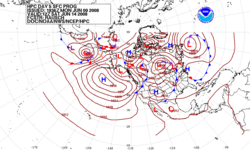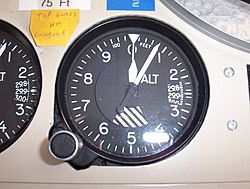Atmospheric pressure
Atmospheric pressure is a force in an area pushing against a surface by the weight of the atmosphere of Earth, a layer of air. The air is not distributed evenly around the globe. It moves, and at different times, the layer of air is thicker in some places than in others. Where the layer of air is thicker, there is more air. Since there is more air, there is a higher pressure in that spot. Where the layer of air is thinner, there is a lower atmospheric pressure.
At higher altitude, the atmospheric density and pressure are lower. This is because high places do not have as much air above them, pushing down.
Barometers can be used to measure atmospheric pressure for meteorology.[1] There is the same atmospheric pressure from all directions. The SI unit for pressure is hPa. Other units such as bar and torr are used for various applications.
Atmospheric Pressure Media
15-year average mean sea-level pressure for June, July, and August (top) and December, January, and February (bottom). ERA-15 re-analysis.
Kollsman-type barometric aircraft altimeter.
Cloud formation above Snæfellsjökull (Iceland), formed above the mountain by orographic lift
Hurricane Wilma on 19 October 2005. The pressure in the eye of the storm was 882 hPa (12.79 psi) at the time the image was taken.
References
- ↑ "atmospheric pressure -- Britannica Online Encyclopedia". britannica.com. Retrieved 11 August 2010.
Other websites
- "Experiment of soda cans being crushed using atmospheric pressure". teachertube.com. Retrieved 11 August 2010.
- Atmospheric pressure Citizendium







